


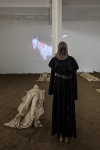

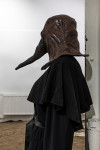













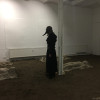
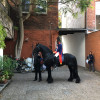
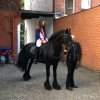
Puppies Puppies
Plague
All bleeding stops eventually
August 25th, 2019
I’m at a beach club on the Ligurian coast called Porteghetto. The club is set into a blasted rock face with a large two-tiered terrace and space for 22 umbrellas. Under each umbrella is a set of chaises longues. I’ve been lying here for the better part of a week to the point that my intestines are now sunburned. The club itself is two stories of whitewash; the sort of building that gives the impression that Richard Meier could’ve been a chicken or an egg. The kitchen is a dark, narrow, windowless closet wedged between a rock face and the bar that serves the upstairs dining patio. The Italian wait staff wears white polo shirts with black collars and Porteghetto stitched into the back collar. The Bangladeshi chef is dressed in all black with a black apron and flips his collar up so it reads Portoghetto upside down. The lifeguard sits in a wooden tower, is handsome, slightly petit and wears a red t-shirt that says SALVATAGGIO in white. The lifeguard, chef, and wait staff smile easily while maintaining the casual distance necessary to create a sense that one could fall into private revelry while amongst a group of people in a delimited space. Sorry if this is a bit tedious but I thought it would be best if you could literally see where I’m coming from. I think I need you to see the earth I’m standing on since we’re all on such different planets. The water is calm and perfect. I’ve been snorkeling and thinking about the fact that in the last 5 years, 13,570 people have drowned in this same water. 32 days ago, 150 people drowned trying to reach Italy from Libya in a single incident. Sorry, you probably know this. And in any case, I’m having a very nice time at the beach club. The snorkeling is very relaxing the water is very cool and refreshing, and there are more fish then I expected. There are anchovies, sardines, and sprats. Sargo are a rather plain and common white fish and they are, as is common in the ocean, a protandrous sequential hermaphrodite, starting out as male, and sometimes becoming female. Sargo are all over the place, not just in front of me while I swim, but stretching from the eastern Atlantic to the western Indian Ocean, from the Bay of Biscay southwards to South Africa and off of the Madeira and Canary Islands. They are also known as sea bream and they are ancient. People ate 3,700 tons of them last year. In the last few years, reports that sargo have become more aggressive and begun biting swimmers have been confirmed throughout the Mediterranean. A spectacular newcomer to the warming waters along the Ligurian coast is the ornate wrasse which have two distinct styles of mating: either a harem or an orgy, depending on population density. The male’s head is fire red with delicate sky blue tributaries shooting across his face like the mouth of the Nile. The females are lovely though slightly more muted with more greens and pale blues and stripes running vertically. They are also sequential hermaphrodites, however, their sexual transformation is from female to male. The transition involves elaborate color transformations and provides for a wide variety of combinations of patterns of reds, oranges, greens, purples and sky blues, a spectrum of sexual orientation. They are attractive fish and I find myself seeking them out. They are the highlight of each swim and while they are also ancient, they are new to the area, having arrived with the warming sea.
I’m reading in the paper that Neil deGrasse Tyson will keep his job at the Hayden Planetarium after a sexual misconduct probe was conducted over allegations brought by two women. In one alleged episode from 2009, Katelyn Allers, an associate professor of physics and astronomy at Bucknell University in Pennsylvania, said Tyson put his hand under the shoulder part of her dress while exploring her tattoo of the solar system to see if it included Pluto. Allers said the behavior was »creepy«.
The second case involved Ashley Watson, who quit her job as an assistant for Tyson on the Fox TV show Cosmos last year after what she said was inappropriate behavior on his part. In one instance, Watson said Tyson invited her into his apartment and told her he wanted to hug her but if he did he’d »just want more.«
The other day, Tyson posted that the recent mass murder by white supremacists in El Paso should be looked at in perspective. »In the past 48hrs, the USA horrifically lost 34 people to mass shootings,« Tyson wrote , claiming, »on average, across any 48hrs, we also lose…
500 to Medical errors
300 to the Flu
250 to Suicide
200 to Car Accidents
40 to Homicide via Handgun.«
»Often our emotions respond more to spectacle than to data,« he added. Many people took offense taking to Twitter to condemn the post and its timing as insensitive. Others condemned the astrophysicist for implying that intentional attacks and accidental deaths were comparable.
»The flu doesn’t target people based on their race,« one commenter wrote on Twitter, alluding to the racist motivation behind the El Paso shooting, which federal law enforcement officials are investigating as a hate crime. »This is the most heartless tweet in the history of social media,« another responded on Twitter.
Puppies Puppies lives in Los Angeles just off the corner of Rampart and 3rd. The building is a typically weird large LA craftsman with art nouveau detailing and it sits high up off the street on a two-tiered faux Italian palazzo terrace. It's the kind of terrace that would face Lake Cuomo, except, rather than an expanse of calm water one sees Rampart and 3rd. A garage at ground level is set into the base of the terrace with the name (word) »Beaulyland« carved (embossed), over the garage door. The interior of the house has a broad staircase, heavy banister, and exposed beams. Puppies lives in a small room with high ceilings leading to a large balcony overlooking the terraces below. Her room is more of a passage with a loft that can be accessed by a precarious system of plinths and ladders that leads up to a bed. Though she is very attached to her roommates, Puppies considers this to be temporary housing. She is thinking of moving to NYC with one of her roommates or maybe Europe.
Europe is different from America. Puppies worries that if she moves to Europe she won’t be able to make her work which is made of American refuse and detritus. I told her that Manfred Pernice once told me something similar. He worried that if they tore down the Plattenbau around Alexanderplatz where he lives that he wouldn’t be able to make his work anymore. I don’t know how seriously to take Manfred and Puppies about this sort of thing.
Puppies will do (and by the time you read this dear reader, she will have done) a series of performances at Kölnischer Kunstverein, Bonner Kunstverein and Kunstverein Düsseldorf as part of an exhibition at all three institutions called Maskulinitaeten. The performance which consists of Puppies standing naked in a space is called Naked Self (Transitioning) (22 Months on Hormone Replacement Therapy). Sorry to make this all about me but I was in a show at MMK in Frankfurt last year called I AM A PROBLEM. It was a really big weird show with lots of art. The curator had made a huge inflatable black shiny plastic tunnel that ran almost the entire length of the exhibition, it ran around corners and you could walk into its shiny black mouth and watch a series of Hollywood blood and green ketchup videos by Sturtevant while feeling and hearing the rush of wind coursing past you from the enormous industrial fan that kept the tunnel inflated. There were also a series of large round transparent windows looking into the tunnel on the other side of which the curator had placed artworks like Andy Warhol’s Brillo Box and some other stuff I can’t remember. What I do remember was a life-size sculpture of a woman with a distinctly grey pallor sitting in a folding chair by John De Andrea. This grey was not the light grey pallor we associate with under oxygenated blood, but a deeper, more intentional grey. This was a woman painted grey. The eyes were natural and had a rim of flesh color around them. Her nails were likewise natural, as was her hair. Then the curator told me that the grey woman had been gifted to the museum by a German collector who had immediately afterward had himself euthanized in Switzerland. I think Puppies will find that European refuse is just as sad as American refuse.
September 1st, 2019
Puppies sent me an email last week saying that the show will be called »Plague« and the entire space will be covered in mulch and dirt.
There will be around nine mannequins laying on the ground scattered in the space (dead). She was thinking about taking bed sheets soaked with muddy water and draping them on the mannequins. The windows will be boarded up. So far she has five taxidermy rats scattered throughout the space. (She wishes there were more.) There will be a performer standing in the middle of the space dressed as a plague doctor.
She decided to go with the less steampunk version. There will be a life-size vinyl print of a horse whose body has been painted black with a white skeleton describing on the outside what’s happening on the inside.
Puppies will then ride in on a horse; a reenactment of a Trisha Donnelly performance in which she rides in on a horse and recites a small speech of defeat from Napoleon by his courier.
»If it need be termed surrender, then let it be so, for he has surrendered in word, not will. He has said, ‘My fall will be great but it will be useful.’ The emperor has fallen and he rests his weight upon your mind and mine and with this I am electric. I am electric.«
Puppies is thinking about wearing the courier costume like in the Trisha Donnelly but she’s been on a roll doing these nude performances. She gave a lecture naked last night and did a naked photoshoot for a magazine. Basically, after so many costumed performances, it could be interesting to perform nude over and over and over for maybe a year or so. So that’s the gist of the show, she rides into the courtyard on a horse, announces defeat and then she’ll probably sit on the horse for a while.
-Will Benedict
Plague
The gallery is a gravesite, with soft earth underfoot and bodies draped in muddied sheets. A beak-masked medieval doctor presides over this chilling scene, with boarded up windows and taxidermied rats. Dread settles.
Puppies Puppies (Jade Kuriki Olivo) describes this exhibition as an oracle or prophecy, visions of the past and possible future. It conjures the plague as a kind of vast, chaotic gloom. A force beyond comprehension or control that radically reorders everything, just over the edge of side of some tipping point or fault line. Night air. land. Dark energies for dark ages.
Puppies tells me she’s been thinking about »Triumph of Death,« c. 1562, Pieter Bruegel the Elder. It's such a wicked, hedonistic scene. Skeletons ravaging the earth, galloping in, gleeful, unhinged. In the genre of danse macabre, death is portrayed as this great equalizer, coming for us all. In death we may all be equal but how and when we die, expect to die or are expected to die is the ultimate scale of inequality. That gives this fear of things that kill indiscriminately a certain edge. It's said that in medieval times the omnipresence of death gave people this thirst for life, verging on hysteria. Carpe diem.
In Puppies’ other works the costumes sometimes felt like thin screens, or maybe two-way mirrors. The person inside is shielded but that only seems to make them more vulnerable―prone, isolated, not really seen. A costume for a plague doctor manifests this vulnerability in a particular way, a safeguard for something it is so utterly, absurdly defenceless against. Death finds its way in and through―physically, psychologically. What mask does the doctor wear when she comes home to her family at night?
Puppies tells me about the rats that were in the walls of her apartment. I imagine this muffled scratching and scurrying like the low hum of anxiety. Creeping in the background, sometimes hard to locate, then suddenly right next to you. Exploding rat populations in major cities like Los Angeles, New York and Chicago are more than a pest control problem, they are a symptom of larger shifts and stresses: zealous construction, piles of refuse in the streets, warmer weather for breeding.
Puppies sends me links to videos of horses »out,«their skeletal structures painted on their skins, like live anatomical animations. They are incredibly beautiful and melancholic. As an allusion to the horsemen of the apocalypse, the way they flow through obstacle courses takes on a feeling of the inevitable, the vast economic, political and ecological conditions that spiral, vortex-like towards collapse. But the animals are in their element, oblivious, carrying on. The horses, the rats, the mannequins, the stoic performers: all of them hover somewhere between life and death, lightness straining against gravity.
For the opening, Puppies will perform a mimesis of Trisha Donnelly’s demonstration from 2002, in which she road into a gallery on horseback, dressed as a Napoleonic courier, and delivered a declaration of defeat. But the words are laced with . »My fall will be great but it will be useful.«ges as a form of sustenance, multiplicity and continuum. »with this I am electric.«
Whenever I contemplate Puppies’ work a schematic comes to mind. As humans evolved, new parts of the brain were added on like rooms in an expanding house. The oldest parts are still there at the center, the flight-or-flight reptilian brain, with layers built around it: language and logic, emotions and memory, abstraction and metaphor. I experience Puppies’ work like an opening of doors between these rooms, pacing through them on pathways and loops between gut feelings and complexes of meaning. It can be dizzying at times.
The confluence of emotions Puppies describes experiencing in her transition are profound: exhilaration and joy, bleakness and loss. The grave has a symbolic finality that is fundamentally irreconcilable with the ways of memory, the hauntings of the past. How it is constantly revived, relived, re-felt in the present, and how that can feel interminable. Mortality has been a central theme for Puppies from the beginning, reflecting both her early close encounters with death and now moving through the death of an old self. In her work, Puppies gives form to this thing of formlessness, or un-forming, bearing it in all the ways in which it is strange, intimate, unknowable.
-Rose Bouthillier
For a long time, Puppies Puppies’ self-definition as an ambiguous artist-subject was already indicated by the name, since it did not allow drawing conclusions about ethnicity or gender, the social milieu or the number of persons behind Puppies Puppies. This made any kind of attribution, any inference as to the identity impossible, while the inherent rejection/withdrawal simultaneously created a location from which Puppies Puppies could encounter the world and act in it.
Meanwhile, Puppies Puppies have become an established figure, because such open conditions cannot be easily upheld over a longer period of time, especially since, in the art world, products have to be connected to producers. It is a figure based on fantasies owing as much to the texts accompanying the works as to the narrations enveloped in myth that have gone along with Puppies Puppies’ veiled artist identity from the beginning.
Acting in roles, or becoming a figure, is also a basic motif of the works themselves. For example, in her performances and installations, Puppies Puppies plays (Hollywood) characters such as J.K. Rowling’s Lord Voldemort or J.R.R. Tolkien’s Gollum, becomes the Statue of Liberty or a personified part of a red carpet on the red carpet. These readymade characters are just as fabricated as the figure of »Puppies Puppies.« Yet they are more than that: franchises, commodified and mass-cultural versions or revenants of real or imagined predecessors, he figures, never fully merge with them, but instead fill them with their own life. So puppies puppies may turn into Voldemort, but they us the sleeping pills they need to fall asleep and they sleep. It is a becoming Sponge Bob, a becoming Gollum, a becoming Napoleon, but remaining Pupte something about Puppies Puppies themselves. Hyper-connoted universes charged with symbols in which personal and universal motifs are closely intertwined, even though the starting point lies in Puppies Puppies’ life.
Since recently, her »transitioning« has become the moment that permeates everything, the heartbeat of her works, so to speak. This is probably revealed most explicitly by »Jade« emerging from behind the artist(s) figure Puppies Puppies―until of late, hardly anyone knew who they were and only very few have seen them. But the emergence of Puppies Puppies (Jade Kuriki Olivo)―as she now calls herself―takes place in absolute contrast to the greatest possible concealment maintained beforehand, namely, in full exposure. She does'nt simply become visible but stands naked in a foggy gallery space over a longer period of time. Therefore, becoming Puppies Puppies (Jade Kuriki Olivo) not only means becoming a self-determined »I« in public, but also staging oneself, turning oneself into a projection screen, which is looked at and supposed to be looked at.
This becoming a figure, becoming a role, becoming a character, shows that the works of Puppies Puppies (Jade Kuriki Olivo) are not (or not only) about becoming one’s »self« but at the same time raise the question of what the »self« actually is. What shows itself in this showing of oneself? Are we the fantasies we have of ourselves? The figures we embody? The projection screens we provide? And what roles does society make possible, and allow? What realities of life are possible in society? What fictions does it permit in the first place? And what would happen if we took these fictions, which in turn have much deeper, older and darker precursors, seriously as identities?
Shedding the incognito that goes hand in hand with becoming Puppies Puppies (Jade Kuriki Olivo) also places the works in a precarious situation. For along with the emergence, the strategy of concealing authorship, which had been so fundamental until then, also disappears. The »I« becomes increasingly stronger. The difference between motif and author dissolves, motif and author become one. That (too) is a painful process, since it is not clear where it will lead to and how it will end. But as usual, this process is made public and reflected upon in public, when Puppies Puppies (Jade Kuriki Olivo) re-enacts a performance by Trisha Donnelly at the opening and rides on horseback into the gallery as a Napoleonic courier to declare his defeat with the words: »My fall will be great but it will be useful.«
-Stefanie Kleefeld
Curated by Stefanie Kleefeld
Programme
»Children guide children« & »Children's Club« with Friederike Seneberg
Saturdy, 28 September 2019, 11am – 1pm
Workshop for children and teenagers aged 6 to 12
Free entrance
Registration: vermittlung@halle-fuer-kunst.de
»Can you feel it?«
Workshop in cooperation with Checkpoint Queer
Sunday, 20 October 2019, 12am – 6pm
For teenagers aged 14 to 21
Free entrance
Registration: vermittlung@halle-fuer-kunst.de
Guided tour
Thursday, 24 October 2019, 7pm
The annual program at Halle für Kunst Lüneburg is generously supported by Land Niedersachsen, Lüneburgischer Landschaftsverband, Sparkassenstiftung Lüneburg and Hansestadt Lüneburg. The education program is supported by Land Niedersachsen.
Works by Puppies Puppies (Jade Kuriki Olivo) (*1989 Texas) have been presented et.al. at Remain Modern, Saskatoon (2019), Kölnischer Kunstverein, Cologne (2019), Kunstverein für die Rheinlande und Westfalen, Düsseldorf (2019), SALTS, Basel (2019), Balice Hertling, Paris (2019, 2016), Queer Thoughts, New York (2019, 2017), Galerie Barbara Weiss, Berlin (2018), What Pipeline, Detroit (2018, 2015), Halle fuer Kunst Lueneburg (2018, 2015), Overduin & Co, Los Angeles (2017), MoMA PS1, New York (2017), Kunsthalle Bern (2017), Whitney Museum, New York (2017) and Bergen Kunsthall (2014).